Submitted:
05 January 2023
Posted:
09 January 2023
You are already at the latest version
Abstract
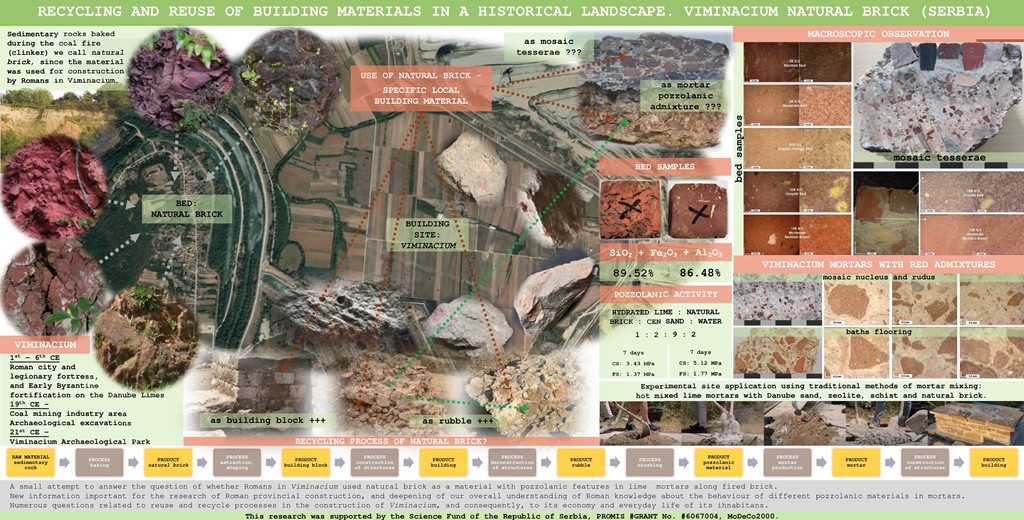
Keywords:
1. Introduction
2. Archaeology and Landscape
2.1. Historical Use of Natural Brick
2.2. Geology of Natural Brick
3. Laboratory research and Experimental Application
3.1. Macroscopic Observations, Methods and Results
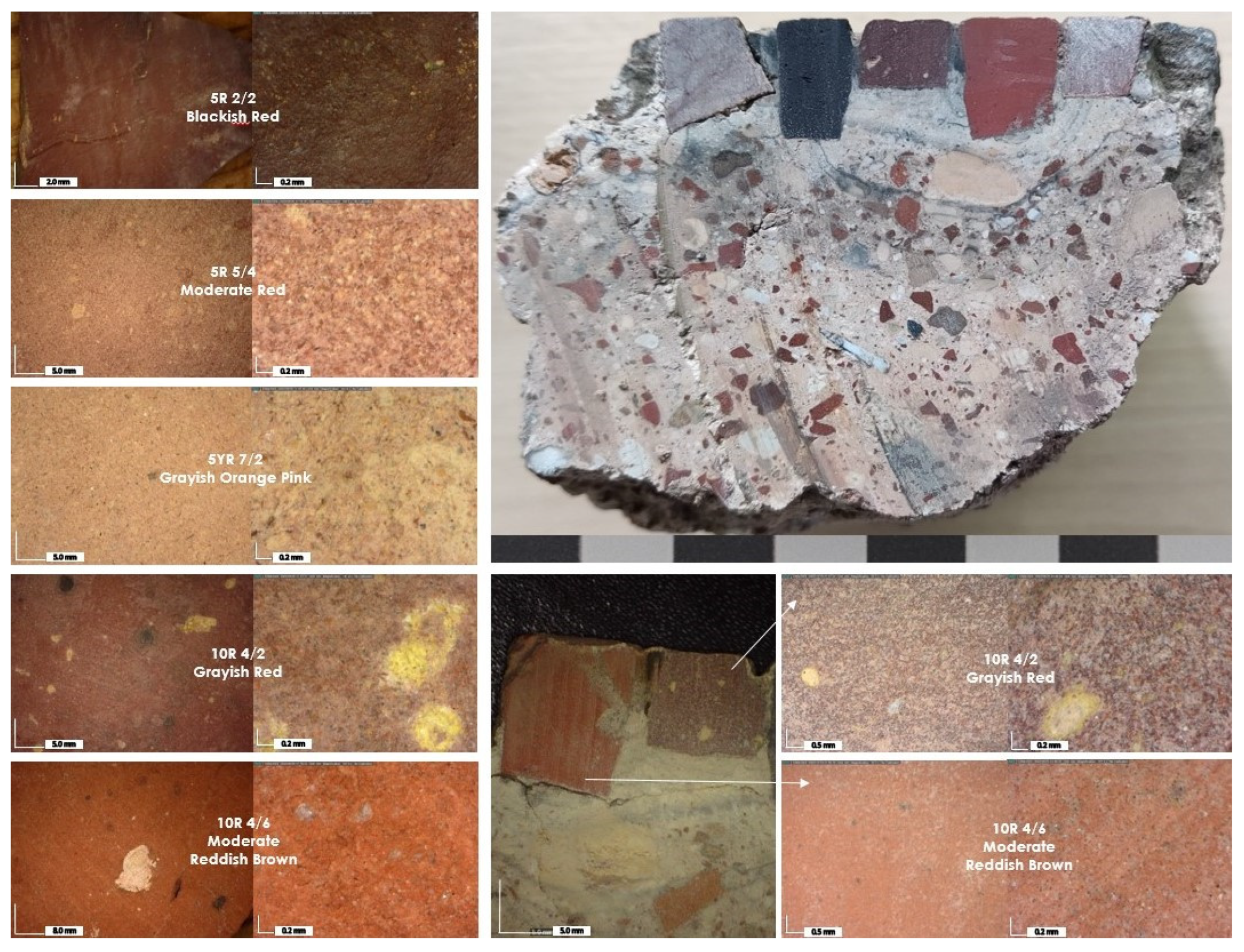
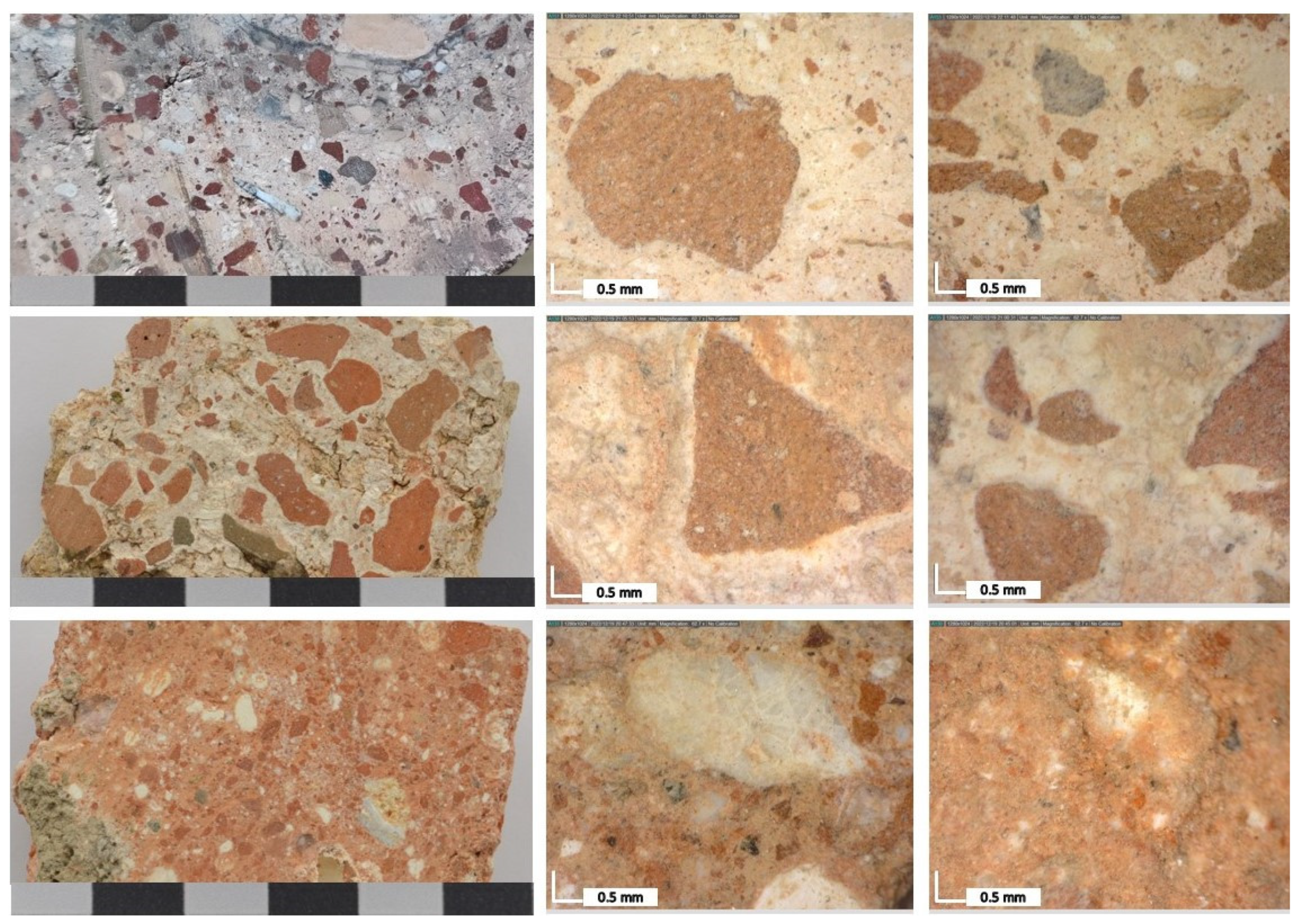

3.2. Physical and Mechanical Characteristics, Methods and Results
3.3. Chemical Analyses, Methods and Results
3.4. Pozzolanic Activity, Methods and Results
3.5. Experimental Application
4. Discussion
5. Conclusions
Author Contributions
Funding
Institutional Review Board Statement
Informed Consent Statement
Data Availability Statement
Acknowledgments
Conflicts of Interest
References
- Boëthius, A. Etruscan and Early Roman Architecture, 2nd ed.; Penguin Books Ltd.: Middlesex, England, UK, 1978. [Google Scholar]
- Sear, F. Roman Architecture; Cornell University Press: NewYork, USA, 1983. [Google Scholar]
- Taylor, R. Roman Builders. A Study in Architectural Process, 2nd ed.; Cambridge University Press: NewYork, USA, 2006. [Google Scholar]
- Hopkins, J.N. The Genesis of Roman Architecture; Yale University Press: New Haven, USA, London, UK, 2016. [Google Scholar]
- Korać, M.; Golubović, S.; Mrđić, N.; Jeremić, G.; Pop-Lazić, S. Frontiers of the Roman Empire. Roman Limes in Serbia; Institute of Archaeology: Belgrade, Serbia, 2014. [Google Scholar]
- Breeze, D.J. Frontiers of the Roman Empire. Archaeol. Dialogues 2008, 15, 55–56. [Google Scholar] [CrossRef]
- Ployer, R.; Polak, M.; Schmidt, R. The Frontiers of the Roman Empire. A Thematic Study and Proposed World Heritage Nomination Strategy; Bundesdenkmalamt Österreich, Radboud Universiteit Nijmegen, Bayerisches: Vienna, Nijmegen, Munich, 2017. [Google Scholar]
- Jilek, S. Frontiers of the Roman Empire. The Danube Limes, A Roman River Frontier. Antiquity of Southeastern Europe Research Center, Warsaw University: Warsaw, Poland, 2009.
- Mirković, M. Moesia Superior: eine Provinz an der mittleren Donau; Von Zabern: Mainz am Rhein, 2007. [Google Scholar]
- Popović, P. (Ed.) . Roman Limes on the Middle and Lower Danube; Archeological Institute: Belgrade, Serbia, 1996. [Google Scholar]
- Nikolić, E.; Jovičić, M. (Eds.) 1st International Conference with Workshop. Science for Conservation of the Danube Limes. Mortar Design for Conservation – Danube Roman Frontier 2000 Years After, Programme and Abstracts, Viminacium, Serbia, June 27 – July 01 2022; Institute of Archaeology: Belgrade, Serbia, 2022. [Google Scholar]
- Spasić-Đurić, D. Grad Viminacijum; Narodni muzej Požarevac: Požarevac, 2015. [Google Scholar]
- Korać, M. Viminacium. Viminacium Urbs et Castra Legionis: Research, Protection, Presentation and Valorization; Institute of Archaeology: Belgrade, Serbia, 2019. [Google Scholar]
- Pejić, B.: Janošević. D. Beočug stoleća. In Združeno elektroprivredno preduzeće Srbije – IEK Kostolac 1870-1970; Marković, S., Ed.; IEK Kostolac: Kostolac, 1971; pp. 57–74. [Google Scholar]
- Simić, V. Dve trećine veka. In Združeno elektroprivredno preduzeće Srbije – IEK Kostolac 1870-1970; Marković, S., Ed.; IEK Kostolac: Kostolac, 1971; pp. 75–76. [Google Scholar]
- Anđelković, V. 140 godina rudnika Kostolac 1870-2010; PD TE-KO Kostolac: Kostolac, 2010. [Google Scholar]
- Vučetić, M. Iz istorije srpskih ugljenokopa: Jame kostolačkog majdana; JP EPS: Beograd, 2010. [Google Scholar]
- Duckworth, C.; Wilson, A.; Van Oyen, A.; Alexander, C.; Evans, J.; Green, C.; Mattingly, D.J. When the Statue is Both Marble and Lime. In Recycling and Reuse in the Roman Economy; Duckworth, C.N., Wilson, A., Eds.; Oxford University Press: Oxford, England, UK, 2020; pp. 449–460. [Google Scholar]
- Munro, B. Approaching Architectural Recycling in Roman and Later Roman Villas. In TRAC 2010: Procedings of the Twentieth Annual Theoretical Roman Archaeology Conference, Oxford, England, UK, 25-28 March 2010; Mladenović, D., Russel, N.B., Eds.; Oxbow Books: Oxford, UK, 2011; pp. 76–88. [Google Scholar]
- Peña, J. T. Recycling in the Roman World: Concepts, Questions, Materials, and Organization. In Recycling and Reuse in the Roman Economy; Duckworth, C.N., Wilson, A., Eds.; Oxford University Press: Oxford, England, UK, 2020; pp. 9–60. [Google Scholar]
- Jeremić, M. Viminacium – Kostolac: Arhitektura na lokalitetu “Više Burdelja”. Arheološki pregled 1977, 19, 55–57. [Google Scholar]
- Jeremić, M. Grobne konstrukcije nekropole na lokalitetu “Više Burdelja”. Arheološki pregled 1977, 19, 57–60. [Google Scholar]
- Jordović, Č. Viminacium, Kostolac: Velika Kapija – rimska nekropola i naselje. Arheološki pregled 1980, 21, 123–126. [Google Scholar]
- Milošević, G. Ranovizantijska arhitektura na Svetinji u Kostolcu. Starinar 1988, 1987, 39–58. [Google Scholar]
- Popović, M. Svetinja, novi podaci o ranovizantijskom Viminacijumu. Starinar 1988, 1987, 1–37. [Google Scholar]
- Danković, I.; Milovanović, B.; Mikić, I. Zaštitna arheološka iskopavanja na lokalitetu Pirivoj (Viminacijum) 2016. godine. In Arheologija u Srbiji. Projekti Arheološkog instituta u 2016. godini; Bugarski, I., Vitas, N.G., Filipović, V., Eds.; Arheološki institut: Beograd, 2018; pp. 35–42. [Google Scholar]
- Nikolić, E. Konstrukcija, dekonstrukcija i rekonstrukcija Viminacijuma. Kontekst i concept. Ph.D. Thesis, University of Belgrade, Belgrade, 2018. [Google Scholar]
- Nikolić, S.; Stojić, G.; Marjanović, M. Istraživanja na lokalitetu Čair – castrum (Viminacijum) 2016. godine. In Arheologija u Srbiji. Projekti Arheološkog instituta u 2016. godini; Bugarski, I., Vitas, N.G., Filipović, V., Eds.; Arheološki institut: Beograd, 2018; pp. 68–78. [Google Scholar]
- Nikolić, S.; Stojić, G.; Marjanović, M. Arheološka istraživanja prostora zapadno od viminacijumskog amfiteatra u 2016. godini. In Arheologija u Srbiji. Projekti Arheološkog instituta u 2016. godini; Bugarski, I., Vitas, N.G., Filipović, V., Eds.; Arheološki institut: Beograd, 2018; pp. 61–67. [Google Scholar]
- Nikolić, S.; Stojić, G.; Marjanović, M. Legijski logor u Viminacijumu: arheološka istraživanja u zoni zapadnog bedema u 2018. godini. In Arheologija u Srbiji. Projekti Arheološkog instituta u 2018. godini; Vitezović, S., Radišić, M., Obradović, Đ., Eds.; Arheološki institut: Beograd, 2021; pp. 143–156. [Google Scholar]
- Valtrović, M. Otkopavanja u Kostolcu. Starinar 1884, I, 3–142. [Google Scholar]
- Nenadović, S. Uređenje Smederevskog grada. Saopštenja 1956, I, 75–84. [Google Scholar]
- Simić, G:, Simić, Z. Grad Ram. Saopštenja 1984, XVI, 31–55.
- Popović, M.; Ivanišević, V. Grad Braničevo u srednjem veku. Starinar 1988, XXXXIX, 125–179. [Google Scholar]
- Kanic, F. Srbija: zemlja i stanovništvo od rimskog doba do kraja XIX veka I; Sprska književna zadruga: Beograd, 1989. [Google Scholar]
- Cvetković, S. Аntička plastika Smederevske tvrđave – pregled dosadašnjih istraživanja. Smederevski zbornik 2009, 2, 29–43. [Google Scholar]
- Nikolić, E. Contribution to the Study of Roman Architecture in Viminacium: Construction Materials and Building Techniques. Arheologija i prirodne nauke 2013, 8, 21–48. [Google Scholar] [CrossRef]
- Milovanović, B.; Anđelković Grašar, J. Female Power that Protects: Examples of the Apotropaic and Decorative Functions of the Medusa in Roman Visual Culture from the Territory of the Central Balkans. Starinar 2017, LXVII, 167–182. [Google Scholar] [CrossRef]
- Milovanović, B.; Kosanović, I.; Mrđić, N. Arheološka istraživanja na lokalitetu Rit (Viminacijum) u 2016. godini. In Arheologija u Srbiji. Projekti Arheološkog instituta u 2016. godini; Bugarski, I., Vitas, N.G., Filipović, V., Eds.; Arheološki institut: Beograd, 2018; pp. 43–54. [Google Scholar]
- Greene, K. The Archaeology of the Roman Economy; University of California Press: Berkeley and Los Angeles, 1990. [Google Scholar]
- De Laine, J. Production, Transport and On-Site Organisation of Roman Mortars and Plasters. Archaeol Anthropol Sci. 2021, 13, 195. [Google Scholar] [CrossRef]
- Coutelas, A. The Selection and Use of Lime Mortars on the Building Sites of Roman Gaul. Comm. Hum. Litt. 2011, 128, 139–151. [Google Scholar]
- Brandon, C.J.; Hohlfelder, R.L.; Jackson, M.D.; Oleson, J.P. Building for Eternity. The History and Technology of Roman Concrete Engineering in the Sea; Oxbow Press: Oxford, UK, 2015. [Google Scholar]
- Secco, M.; Asscher, Y.; Ricci, G.; Tamburini, S.; Preto, N.; Sharvit, J.; Artioli, G. Cementation processes of Roman pozzolanic binders from Caesarea Maritima (Israel). Const. Build. Mat. 2022, 355, 129128. [Google Scholar] [CrossRef]
- Siddal, R. From Kitchen to Bathhouse: the Use of Waste Ceramics as Pozzolanic Additives in Roman Mortars. In Building Roma Aeterna: Current Research on Roman Mortar and Concrete, Proceedings of the Conference (Commentationes Humanarum Litterarum, 128), Helsinki, Finland, March 27-29, 2008; Ringbom, Å., Hohlfelder, R.L., Sjöberg, P., Sonck-Koota, P., Eds.; Societas Scientiarum Fennica: Helsinki, Finland, 2011; pp. 152–168. [Google Scholar]
- Vitruvije. Vitruvijevih deset knjiga o arhitekturi, trans. M.Lopac; Svjetlost: Sarajevo, 1951. [Google Scholar]
- Jordović, Č. Grnčarski i ciglarski centar u Viminacijumu. Saopštenja 1994, XXVI, 95–106. [Google Scholar]
- Jovičić, M.; Milovanović, B. Roman Brick Kiln from the Eastern Necropolis of Viminacium. Arheologija i prirodne nauke 2017, 12, 19–36. [Google Scholar] [CrossRef]
- Raičković, A. Keramičke posude zanataskog centra u Viminacijumu; Centar za nove tehnologije, Arheološki institut: Beograd, Srbija, 2007. [Google Scholar]
- Rakić, M. Osnovna geološka karta SFRJ 1:100.000. Tumač za list Bela Crkva; Savezni geološki zavod: Beograd, 1979. [Google Scholar]
- Raičković, A.; Redžić, S. Keramičke i opekarske peći Viminacijuma – lokacije “Pećine” i “Livade kod Ćuprije”. Arheologija i prirodne nauke 2005, 1, 81–106. [Google Scholar] [CrossRef]
- Nikolić, E.; Roter-Blagojević, M. Cultural Landscape of Ancient Viminacium and Modern Kostolac – Creation of a New Approach to the Preservation and Presentation of its Archaeological and Industrial Heritage. In Conference Proceedings, 5th International Academic Conference on Places and Technologies, Belgrade, Serbia, 26-27 April 2018; A. Krstić – Furundžić, M. Vukmirović, E. Vaništa Lazarević, A. Đukić, Ed.; University of Belgrade, Faculty of Architecture: Belgrade, 2018; pp. 785–792. [Google Scholar]
- Nikolić, E.; Tapavički-Ilić, M.; Delić-Nikolić, I. Viminacium Landscape (Trans)formation. In Handbook of Cultural Analysis; S D’Amico, V.Venuti, Ed.; Springer Nature: Dordrecht, Netherlands, 2022; pp. 2073–2017. [Google Scholar]
- Nikolić, E.; Delić-Nikolić, I.; Miličić, Lj.; Jovičić, M. Natural Brick of Viminacium. In Serbian Ceramic Society Conference. Advanced Ceramics and Application X, New Frontiers in Multifunctional Material Science and Processing, Program and the Book of Abstracts, Belgrade, Serbia, 21-23 September 2022; Obradović, N., Mančić, L., Eds.; Serbian Ceramic Society: Belgrade, 2022; p. 50. [Google Scholar]
- Vasić, M. Izveštaj Srpskoj kraljevskoj akademiji nauka o iskopavanju u Kostocu u god. 1902. Godišnjak Srpske Kraljevske Akademije 1903, XVI, 201–228. [Google Scholar]
- Vassits, M. Funde in Serbien. Sonder-Abdruck aus dem Jahrbuch des Kaiserlich Deutschen Archaologischne Instituts 1903, XX, 102–109. [Google Scholar]
- Dušanić, S. Aspects of Roman Mining in Pannonia, Noricum, Dalmatia and Mosesia Superior, In Aufstieg und Niedergang der Romischeb Welt 2, no. 6; Temporini, H., Band, S., Haase, W., Eds.; Walter de Gruyter: Berlin, 1977; pp. 52–94. [Google Scholar]
- Nikolić, E.; Rogić, D. Short Observations on the Possible Hydraulicity of Viminacium Lime Mortars Based on the Results of Laboratory Research. Arheologija i prirodne nauke 2018, 14, 39–49. [Google Scholar] [CrossRef]
- Nikolić, S.; Stojić, G.; Marjanović, M. Arheološka istraživanja prostora zapadno od viminacijumskog amfiteatra u 2017. godini. In Arheologija u Srbiji. Projekti Arheološkog instituta u 2017. godini; Bugarski, I., Vitas, N.G., Filipović, V., Eds.; Arheološki institut: Beograd, 2019; pp. 117–124. [Google Scholar]
- Bogdanović, I.; Jevtović, Lj.; Golubović, S. Legijski logor u Viminacijumu: arheološka istraživanja severnog bedema u 2018. godini. In Arheologija u Srbiji. Projekti Arheološkog instituta u 2018. godini; Vitezović, S., Radišić, M., Obradović, Đ., Eds.; Arheološki institut: Beograd, 2021; pp. 157–172. [Google Scholar]
- Bogdanović, I.; Jevtović, Lj.; Stojić, G. Legijski logor u Viminacijumu: sistematska istraživanja severozapadnog dela utvrđenja u 2019. godini. In Arheologija u Srbiji. Projekti Arheološkog instituta u 2018. godini; Vitezović, S., Radišić, M., Obradović, Đ., Eds.; Arheološki institut: Beograd, 2021; pp. 89–104. [Google Scholar]
- Stojić, G.; Marjanović, M. Legijski logor u Viminacijumu: arheološka istraživanja u zoni zapadnog bedema u 2019. godini. In Arheologija u Srbiji. Projekti Arheološkog instituta u 2018. godini; Vitezović, S., Radišić, M., Obradović, Đ., Eds.; Arheološki institut: Beograd, 2021; pp. 105–120. [Google Scholar]
- Blagojević, M. Viminacijum – zaštitna arheološka iskopavanja na lokalitetima ugroženim radom površinskog kopa Drmno. Glasnik Društva konzervatora Srbije, 2005, 29, 39–42. [Google Scholar]
- Milovanović, B.; Mrđić, N.; Kosanović, I. Arheološka istraživanja na lokalitetu Rit (Viminacijum) u 2017. godini. In Arheologija u Srbiji. Projekti Arheološkog instituta u 2017. godini; Bugarski, I., Filipović, V., Vitas, N.G., Eds.; Arheološki institut: Beograd, 2019; pp. 97–108. [Google Scholar]
- Golubović, S.; Korać, M. The Recent Discovery of a Temple Complex in Viminacium. Bollettino di Archaeologia on Line - special edition 2008, 33–36. [Google Scholar]
- Nikolić, S.; Bogdanović, I. Istraživanja viminacijumskog amfiteatra u toku 2011. godine. In Arheologija u Srbiji. Projekti Arheološkog instituta u 2011. godini; Bikić, V., Golubović, S., Antonović, D., Eds.; Arheološki institut: Beograd, 2012; pp. 42–45. [Google Scholar]
- Nikolić, S. ; Bogdanović, I,; Jevtović, Lj. Stojić, G. Arheološka istraživanja viminacijumskog amfiteatra u 2013. godini. In Arheologija u Srbiji. Projekti Arheološkog instituta u 2013. godini, Antonović, D., Eds.; Arheološki institut: Beograd, 2014; pp. 48–53. [Google Scholar]
- Nikolić, S.; Stojić, G.; Marjanović, M. ; Bogdanović, I,; JevtovićLj. Istraživanja na lokalitetu Čair – castrum (Viminacijum) 2017. godine. In Arheologija u Srbiji. Projekti Arheološkog instituta u 2017. godini; I., Bugarski, N. GavrilovićI., Vitas, V.N.G., Filipović, V., Ed.; Arheološki institut: Beograd, 2019; pp. 125–134. [Google Scholar]
- Le Blanc, R.J. Prehistoric Clinker Use on the Cape Bathurst Peninsula, Northwest Territories, Canada: The Dynamics of Formation and Procurement. Am. Antiq. 1991, 56, 268–277. [Google Scholar] [CrossRef]
- Kristensen, T.J.; Andrews, T.D.; MacKay, G.; Gotthardt; Lynch, S. C.; Duke, M.J.M.; Locock, A.J.; Ives, J.W. Identifying and Sourcing Pyrometamorphic Artifacts: Clinker in Subarctic North America and the Hunter-Gatherer Response to a Late Holocene Volcanic Eruption. J. Archaeol. Sci. Rep. 2019, 23, 773–790. [Google Scholar]
- Estes, M.B.; Ritterbush, L.W.; Nicolaysen, K. Clinker, Pumice, Scoria, or Paralava? Vesicular Artifacts of the Lower Missouri Basin. Plains Anthropol. 2010, 55, 67–81. [Google Scholar] [CrossRef]
- Heffern, E.L.; Reiners, P. W.; Naeser, C.W.; Coates, D.A. Chronology of Clinker and Implications for Evolution of the Powder River Basin Landscape, Wyoming and Montana. GSA Rev. Eng. Geol. 2007, XVIII, 155–175. [Google Scholar]
- Antonović, D. (Institute of Archaeology, Belgrade, Serbia). Personal communication, 2022.
- Allen, J.R.; Fulford, M.G. Early Roman Mosaic Materials in Southern Britain, with Particular Reference to Silchester (Calleva Atrebatum): A Regional Geological Perspective. Britannia 2004, 35, 9–38. [Google Scholar] [CrossRef]
- Nikolić, E.; Rogić, D.; Milovanović, B. The Role of Brick in the Hydraulicity of Viminacium Mortars: Decorative Mortars from the Thermae. Arheologija i prirodne nauke 2015, 10, 71–92. [Google Scholar] [CrossRef]
- Marić, R. Iskopavanja na Orašju, prethodni izveštaj o radovima u 1945–1949. godini. Starinar 1951, II, 113–132. [Google Scholar]
- Milošević, G. Stanovanje u srednjovekovnoj Srbiji; Arheološki institut: Beograd, 1997. [Google Scholar]
- Mladenović, O.; Jovičić, M.; Danković, I. Scordisci Settlement at the Sites of Rit and Nad Klepečkom. In Viminacium in Prehistory, Excavations 2005–2015; A. Kapuran, A. Bulatović. S. Golubović, V. Filipović, Ed.; Institute of Archaeology: Belgrade, 2019. [Google Scholar]
- Janaćković, Đ.; Radovanović, B.; Dimitrijević, A. Mogućnosti i pravci razvoja proizvodnje graðevinskog materijala na sirovinskom području Kostolačkog basena. In Savetovanje Energetski kompleks Kostolac i životna sredina, zbornik radova; Grujić, N., Đorđević-Moiloradović, J., Jovanović, D., Paunović, V., Feldić, D., Eds.; Savez Društava inženjera i tehničara opštine Požarevac: Požarevac, 2002; pp. 176–177. [Google Scholar]
- Hoffman, G.K. Natural Clinker— the Red Dog of Aggregates in the Southwest. In Proceedings of the 31st Forum on the Geology of Industrial Minerals – The Borderland Forum, El Paso, Texas, 23-28 April 1995; Austin, G.S., Hoffman, G.K., Barker, J.M., Zidek, J., Gilson, N., Eds.; Authority of State of New Mexico: Socorro, New Mexico, USA, 1996; pp. 187–195. [Google Scholar]
- Langer, W.H. Aggregate Resource Availability in the Conterminous United States, Including Suggestions for Addressing Shortages, Quality, and Environmental Concerns, Open-File Report 2011–1119; US Geological Survey: Reston, Virginia, 2011. [Google Scholar]
- Rogers, G. Baked Shale and Slag Formed by the Burning of Coal Beds – Professional Paper 108-A; Department of the Interior and United States Geological Survey: Washington.
- Cosca, M.A.; Essene, E.J.; Geissman, J.W.; Simmons, W.B.; Coates, D.A. Pyrometamorphic Rocks Associated with Naturally Burned Coal Beds, Powder River Basin, Wyoming, Am. Mineral. 1989, 74, 85–100. [Google Scholar]
- Quintero, J.A.; Candela, S.A.; Ríos, C.A.; Montes, C.; Uribe. C. Int. J. Coal Geol. 2009, 80, 196–210. [Google Scholar] [CrossRef]
- Grapes, R.; Zhang, K.; Peng, Z.-I. Paralava and Clinker Products of Coal Combustion, Yellow River, Shanxi Province, China. Lithos 2009, 113, 831–843. [Google Scholar] [CrossRef]
- Žáček, V.; Skála, R. , Dvořák, Z. Petrologie a mineralogie porcelanitů mostecké pánve– produktů fosilní ch požárů neogénníh nědouhelné sloje. Bulletin mineralogicko-petrologické hooddělení Národníh o muzeav Praze 2010, 18, 1–32. [Google Scholar]
- Rădan, S.-C.; Rădan, S. Paleo-Coal Fires in Romania. In Coal and Peat Fires: A Global Perspective, vol.2: Photographs and Multimedia Tours; GStracher, B., Prakash, A., Sokol, E.V., Eds.; Elsevier: Amsterdam, Netherlands, 2012; pp. 339–349. [Google Scholar]
- Novikova, S.A.; Sokol, E.V.; Novikov, I.S.; Travin, A.V. Ancient Coal Fires on the Southwestern Periphery of the Kuznetsk Basin, West Siberia, Russia: Geology and Geochronology. In Coal and Peat Fires: A Global Perspective, vol.3: Case Studies – Coal Fires; Stracher, G.B., Prakash, A., Sokol, E.V., Eds.; Elsevier: Amsterdam, Netherlands, 2015; pp. 509–541. [Google Scholar]
- Laita, E.; Bauluz, B.; Yuste, A. High-Temperature Mineral Phases Generated in Natural Clinkers by Spontaneous Combustion of Coal. Minerals 2019, 9, 1–17. [Google Scholar] [CrossRef]
- Chen, B.; Wang, Y.; Franceschi, M.; Duan, X.; Li, K.; Yu, Y.; Wang, M.; Shi, Z. Petrography, Mineralogy, and Geochemistry of Combustion Metamorphic Rocks in the Northeastern Ordos Basin, China: Implications for the Origin of “White Sandstone”. Minerals 2020, 10, 1086. [Google Scholar] [CrossRef]
- Grapes, R. Pyrometamorhism, 2nd ed.; Springer: Heidelberg, Dordrecht, London, New York, Germany, Netherlands, USA, England, 2011. [Google Scholar]
- Heffern, E.L.; Coates, D.A. Geologic History of Natural Coal-bed Fires, Powder River Basin, USA. Int. J. Coal Geol. 2004, 59, 25–47. [Google Scholar] [CrossRef]
- Reiners, P.W.; Rihimaki, C.A.; Heffern, E.L. Clinker Geochronology, the First Glacial Maximum, and Landscape Evolution in the Nothern Rockies. GSA Today 2011, 21, 4–9. [Google Scholar] [CrossRef]
- Goldammer, J.G. The Fire Undeground. Coal Clinkers, Baked Mudstine and Clues to Evolutionary Diversity. Natural History 2019, 9, 32–33. [Google Scholar]
- Kumar Singh, R.V. Spontaneous Heating and Fire in Coal Mines. Procedia Eng. 2013, 62, 78–90. [Google Scholar] [CrossRef]
- Kuenzer, C. Remote and In Situ Mapping of Coal Fires: Case Study from China and India. In Coal and Peat Fires: A Global Perspective, vol.3: Case Studies – Coal Fires; Stracher, G.B., Prakash, A., Sokol, E.V., Eds.; Elsevier: Amsterdam, Netherlands, 2015; pp. 58–93. [Google Scholar]
- Žáček, V.; Skála, R.; Dvořák, Z. Combustion Metamophism in the Most Basin. In Coal and Peat Fires: A Global Perspective, vol.3: Case Studies – Coal Fires; Stracher, G.B., Prakash, A., Sokol, E.V., Eds.; Elsevier: Amsterdam, Netherlands, 2015; pp. 161–202. [Google Scholar]
- Hibsch, J.E. ; Erläuterungen zur geologischen Karte der Umgebung von Brüx. Knihovna Státního geologického ústavu Československé republiky, Praha 11; Nákladem Stát. geologického ústavu Čsl.rep: Praha, 1929. [Google Scholar]
- De Boer, C. B.; Dekkers, M. J.; van Hoof, T. A. M; Rock-Magnetic Properties of TRM Carrying Baked and Molten Rocks Straddling Burnt Coal Seams. Phys. Earth Planet. Inter. 2001, 126, 93–108. [Google Scholar] [CrossRef]
- Filipović, I.; Rodin, V. Osnovna geološka karta SFRJ 1:100.000. Tumač za list Obrenovac; Savezni geološki zavod, Beograd, 1980.
- Čtyřoký, P.; Novák, F. Flyš a medlovické porcelanity v jižní části Chřibů. Čas. Min. Geol. 1978, 23, 77–86. [Google Scholar]
- Osvětimany. Medlovický lom. Available online: https://www.osvetimany.cz/index.php/o-osvetimanech/chriby/chranena-uzemi-medlovicky-lom (accessed on 16 December 2022).
- Radivojević, A. Bricks in Late Antiquity. Records in the Material; University of Belgrade, Faculty of Architecture: Belgrade, 2018. [Google Scholar]
- Raičković, A. Keramičke posude iz grobova tipa Mala Kopašnica Sase. Ph.D. Thesis, University of Belgrade, Belgrade, 2012. [Google Scholar]
- Gutt, W.; Gaze, M.E. Trinidad Porcellanite as a Pozzolan, Mater. Struct. 1975, 8/6, 439–450.
- Jevtić, D.; Zakić, D.; Harak, S. Ispitivanje različitih tipova maltera spravljenih na bazi opekarskog loma. Materijali i konstrukcije 2002, 45, 60–63. [Google Scholar]
- Kolesnikov, D.; Nikolić, D. Višak radne snage i predlozi mogućih rešenja. In Savetovanje Energetski kompleks Kostolac i životna sredina, zbornik radova; Grujić, N., Đorđević-Moiloradović, J., Jovanović, D., Paunović, V., Feldić, D., Eds.; Savez Društava inženjera i tehničara opštine Požarevac: Požarevac, 2002; pp. 189–95. [Google Scholar]
- EN 12407: 2019 Natural Stone Test Methods – Petrographic Examination.
- EN 1926: 2010 Natural stone test methods - Determination of uniaxial compressive strength.
- EN 1936: 2006 Natural stone test methods - Determination of real density and apparent density, and of total and open porosity.
- EN 13755: 2009 Natural stone test methods - Determination of water absorption at atmospheric pressure.
- ASTM C 618-22 Standard Specification for Coal Fly Ash and Raw or Calcined Natural Pozzolan for Use in Concrete.
- Pourkhorhidi, A.R.; Najimi, M.; Parhizkar, T.; Jafarpour, F.; Hillemeier, B. Applicability of the Standard Specifications of ASTM C618 for Evaluation of Natural Pozzolans. Cem. Concr. Compos. 2010, 32, 794–800. [Google Scholar] [CrossRef]
- SRPS B.C1.018: 2015 Nemetalne mineralne sirovine – Pucolanski materijali – Sastojci za proizvodnju cementa – Klasifikacija, tehnički uslovi i metode ispitivanja.
- EN 196-1: 2017 Methods of Testing Cement – Part 1: Determination of Strength.
- Ernst Basler + Partner AG. Bregalnica River Basin Management Project River Basin Management. Ministry of Environment and Physical Planning, State Secretariat for Economic Affairs: Skopje, Macedonia, Zollikon, Switzerland, 2016.
- Kekanović, M.; Čeh, A.; Karaman, G. Betoni od prirodno pečene gline – Požarevac. In Radovi po pozivu saopšteni na savetovanju Održivi razvoj grada Požarevca i energestkog kompleksa Kostolac; Radovanović, B., Ed.; Grad Požarevac: Požarevac, 2011; pp. 23–27. [Google Scholar]
- Walker, R.; Pavia, S. Physical properties and reactivity of pozzolans, and their influence on the properties of lime-pozzolan pastes. Mater. Struct. 2011, 44, 1139–1150. [Google Scholar] [CrossRef]
- Copsey, N. Hot Mixed Lime and Traditional Mortars. A Practical Guide to Their Use in Conservation and Repair, 2nd ed.; The Crowood Press Ltd.: Wilshire, England, UK, 2021. [Google Scholar]
- Adam, J.-P. Roman Building, Materials and Techniques, 2nd ed.; Routledge: London, England, UK, 2005. [Google Scholar]
- Milovanović, B. Skeletal graves of children from the necropolis Više grobalja of ancient Viminacium. VAMZ 2016, 3, 95–122. [Google Scholar]
- Danković, I. Inventar grobova ženske populacije kao odraz životnog doba: studija slučaja viminacijumskih nekropola od I do IV veka. Ph.D. Thesis, University of Belgrade, Belgrade, 2020. [Google Scholar]
- Zotović, Lj. Viminacium. Arheološki pregled 1973, 15, 47–50. [Google Scholar]
- Kondić, V.; Zotović, Lj. Viminacium – rezultati arheoloških istraživanja u 1974. godini. Arheološki pregled 1974, 16, 94–96. [Google Scholar]
- Milovanovič, B. Izveštaj sa sistematskih arheoloških iskopavanja na lokalitetu Terme-Viminacijum 2004. godine. Arheološki pregled 2007, 2, 51–54. [Google Scholar]
- Nikolić, E.; Milovanović, B.; Raičković Savić, A. Contribution to the Study of Roman Architecture in Viminacium: Research of Thermae Masonry Techniques. Archaeologica Bulgarica 2017, XXI, 39–56. [Google Scholar]
- Nikolić, S. ; Bogdanović,. Recent Excavations on the Amphitheatre of Viminacium (Upper Moesia). In Proceedings of the 2nd Congress of Roman Studies, Ruse, Bulgaria, 06-11 September 2012; Vagalinski, L., Sharankov, N., Eds.; National Archaeological Institute with Museum of the Bulgarian Academy of Sciences: Sofia, Bulgaria, 2015; pp. 547–555. [Google Scholar]
- Artioli, G.; Secco, M.; Addis, A. The Vitruvian Legacy: Mortars and Binders Before and After the Roman World. Eur. Mineral. Union Notes Mineral. 2019, 20, 151–202. [Google Scholar]
- Secco, M.; Dilaria, S.; Bonetto, J.; Addis, A.; Tamburini, S.; Pretoe, N.; Ricci, G.; Artioli, G. Technological transfers in the Mediterranean on the verge of Romanization: Insights from the waterproofing renders of Nora (Sardinia, Italy). J. Cult. Herit. 2020, 44, 63–82. [Google Scholar] [CrossRef]
- Elsen, J. Microscopy of Historic Mortars – a Review. Cem. Concr. Res. 2006, 36, 1416–1424. [Google Scholar] [CrossRef]
- Lancaster, L. Concrete Vaulted Construction in Imperial Rome. Innovations in Context; Cambridge University Press: Cambridge, UK, 2005. [Google Scholar]
- Redžić, S.; Danković, I.; Milovanović, B. Zaštitna arheološka iskopavanja na lokalitetu Pirivoj (Viminacijum) tokom 2019. godine. In Arheologija u Srbiji. Projekti Arheološkog instituta u 2019. godini; Vitezović, S., Radišić, M., Obradović, Đ., Eds.; Arheološki institut: Beograd, 2021; pp. 133–146. [Google Scholar]
- Elsen, J.; Van Balen, K.; Mertens, G. Hydraulicity in historic lime mortars: a review. In Historic Mortars: Characterisation, Assessment and repair; Válek, J., Groot, C., Hughes, J., Eds.; Springer-RILEM: Berlin, New York, 2012; pp. 125–139. [Google Scholar]
- Böke, H.; Akkurt, S.; İpekoğlu, B.; Uğurlu, E. Characteristics of Brick used as Aggregare in Historic Brick-Lime Mortars and Plasters. Cem. Concr. Res. 2006, 36, 1115–1122. [Google Scholar] [CrossRef]
- Stefanidou, M. ; Pachta, V; Konopissi, S, Karkadelidou, F., Papayianni, I. Analysis and characterization of hydraulic mortars from ancient cisterns and baths in Greece. Mater. Struct. 2014, 47, 571–580. [Google Scholar]
- Teutonico, J.M.; McCaig, I.; Burns, C.; Ashurst, J. The Smeaton project: Factors aff ecting the properties of lime-based mortars, APT Bulletin 1993, 25, 32–49. 25.
- Livingston, R.A. Materials Analysis of the Masonry of Hagia Sophia Basilica, Istanbul. WIT Trans. Built Environ. 1993, 3, 849–865. [Google Scholar]
- Livingston, R.A.; Stutzman, P.E.; Mark, R.; Erdik, M. et al. Preliminary analysis of the masonry of the Hagia Sophia Basilica, Istanbul, In Symposium J – Materials Issues in Art and Archaeology III; Druzik, J.R., Freestone, I.C., Vandiver, P.B., Wheeler, G.S., Eds.; Cambridge University Press: Cambridge, 1992; pp. 721–736. [Google Scholar]
- Moropolou, A.; Cakmak, A.S.; Biscontin, G.; Bakolas, A.; Zendri, E. Advanced Byzantine Cement Based Composites Resisting Earthquake Stresses: the Crushed Brick / Lime Mortars of Justinian’s Hagia Sophia. Constr. Build. Mater. 2002, 16, 543–552. [Google Scholar] [CrossRef]
- Arsenović, M.; Stanković, S.; Radojević, Z.; Pezo, L. The Effects of Chemical Composition on Firing Temperature in Heavy Clay Brick Production – Chemometric Approach. InterCeram: Int. Ceram. Rev. 2014; 01-02, 26–29. [Google Scholar]
- Nežerka, V.; Slížková, Z.; Tesárek, P. ; Plachý, T; Frankeová, D. ; Petráňová, V. Comprehensive Study on Mechanical Properties of Lime-Based Pastes with Additions of Metakaolin and Brick Dust, Cem. Concr. Res. 2014, 64, 17–29. [Google Scholar]
- Lancaster, L. Innovative Vaulting in the Architecture of the Roman Empire – 1st to 4th Centuries CE; Cambridge University Press: Cambridge, UK, 2015. [Google Scholar]
- Wild, S.; Gailius, A.; Hansen, H.; Pedesron, L.; Szwabowski, J. Comparative Study of Pozzolanic, Chemical and Physical Properties of Clay Bricks in Four European Countries for Utilization of Pulverized Waste Clay Brick in Production of Mortar and Concrete. Build. Res. Inf. 1997, 25, 170–175. [Google Scholar] [CrossRef]
- Karaman, S.; Ersahin, S.; Gunal, H. Firing Temperature and Firing Time Influence on Mechanical and Physical Properties of Clay Bricks. J. Sci. Ind. Res. 2006, 65, 153–159. [Google Scholar]
- Bohara, N. B.; Ghale, D.B.; Chapagin, Y.P.; Duwal, N.; Bhattarai, J. Effect of Firing Temperature on Physico-Mechanical Properties of Contemporary Clay Brick Productions in Lalitpur, Nepal. Bangladesh j. sci. ind. Res 2020, 55, 43–52. [Google Scholar] [CrossRef]
- Özkaya, Ö. A.; Böke, H. Properties of Roman Bricks and Mortars Used in Serapis Temple in the City of Pergamon, Mater. Charact. 2009, 60, 995–1000. [Google Scholar] [CrossRef]
- Badica, P.; Alexandru-Dinu, A.; Grigoroscuta, M.A.; Burdusel, M.; Aldica, G.V.; Sandu, V.; Bartha, C.; Polosan, S.; Galatanu, A.; Kuncser, V.; Enculescu, M.; Locovei, C.; Porosnicu, I.; Tiseanu, I.; Ferbinteanu, M.; Savulescu, I.; Negru, M.; Batalu, N.D. Mud and burnt Roman bricks from Romula. Sci. Rep. 2022, 12, 15864. [Google Scholar] [CrossRef]
- Pérez-Monserrat, E. M.; Causarano, M.-A.; Maritan, L.; Chavarria, A.; Brogiolo, G.P.; Cultrone, G. Roman Brick Production Technologies in Padua (Nothern Italy) along the Late Antiquity and Medieval Times: Durable Bricks on High Humid Environs. J. Cult. Herit. 2022, 54, 12–20. [Google Scholar] [CrossRef]
- Eramo, G.; Maggetti, M. Pottery kiln and drying oven from Aventicum (2nd century AD, Ct. Vaud, Switzerland): Raw materials and temperature distribution. Appl. Clay Sci. 2013, 82, 16–23. [Google Scholar] [CrossRef]
- Garzón, E.; Pérez-Villarejo, L.; Eliche-Quesada, D.; Martínez-Martínez, S.; Sánchez-Soto, P.J. Vitrification Rate and Estimation of the Optimum Firing Conditions of Ceramic Materials from Raw Clays: A Review. Ceram. Int. 2022, 48, 15889–15898. [Google Scholar] [CrossRef]
- Marrese, G.; Tucci, P.; Raičković Savić, A. Roman Pottery from Viminacium (Serbia, 2nd-3rd centuries AD): Compositional Characteristics, Production and Technological Aspects. Arheologija i prirodne nauke 2015, 10, 9–44. [Google Scholar] [CrossRef]
- Stefanidou, M.; Papayianni, I.; Pachta, V. Analysis and Characterization of Roman and Byzantine Fired Bricks from Greece. Mater. Struct. 2015, 48, 2251–2260. [Google Scholar] [CrossRef]
- Lancaster, L. Pozzolans in Mortar in the Roman Empire: An Overview and Thoughts on Future Work. In Mortiers et hydraulique en Méditerranée antique; Bouffier, S., Ortega, I.F., Eds.; Presses Universitaires de Provence: Aix-en-Provence, 2019; pp. 31–39. [Google Scholar]
- Cultrone, G.; Molina, E.; Arizzi, A. The combined use of petrographic, chemical and physical techniques to define the technological features of Iberian ceramics from the Canto Tortoso area (Granada, Spain). Ceram. Int. 2014, 40, 10803–10816. [Google Scholar] [CrossRef]
- Rădan, S.-C.; Rădan, S. Coal Paleofires in the Western Dacic Basin (Romania): Geophysical, Mineralogical and Geochemical Signatures Recovered From Porcelanites and Clinkers; A Case History. In Abstracts of the Twelfth Castle Meeting on New Trends in Geomagnetism, Paleo, Rock and Environmental Magnetism; Castle of Nové Hrady, Czech Republic, Avgust 29–September 4, 2010; Institute of Geophysics, Academy of Sciences of the Czech Republic: Prague, 2010; pp. 66–67. [Google Scholar]
- Mogetta, M. A New Date for Concrete in Rome. J. Rom. Stud. 2015, 195, 1–40. [Google Scholar] [CrossRef]
- Rodwell, D. Conservation and Sustainability in Historic Cities; Blackwell Publishing Ltd.: Oxford, England, UK, 2007. [Google Scholar]
- Lafrenz Samuels, K. ; Value and Significance in Archaeology. Archaeol. Dialogues 2008, 15, 71–97. [Google Scholar] [CrossRef]
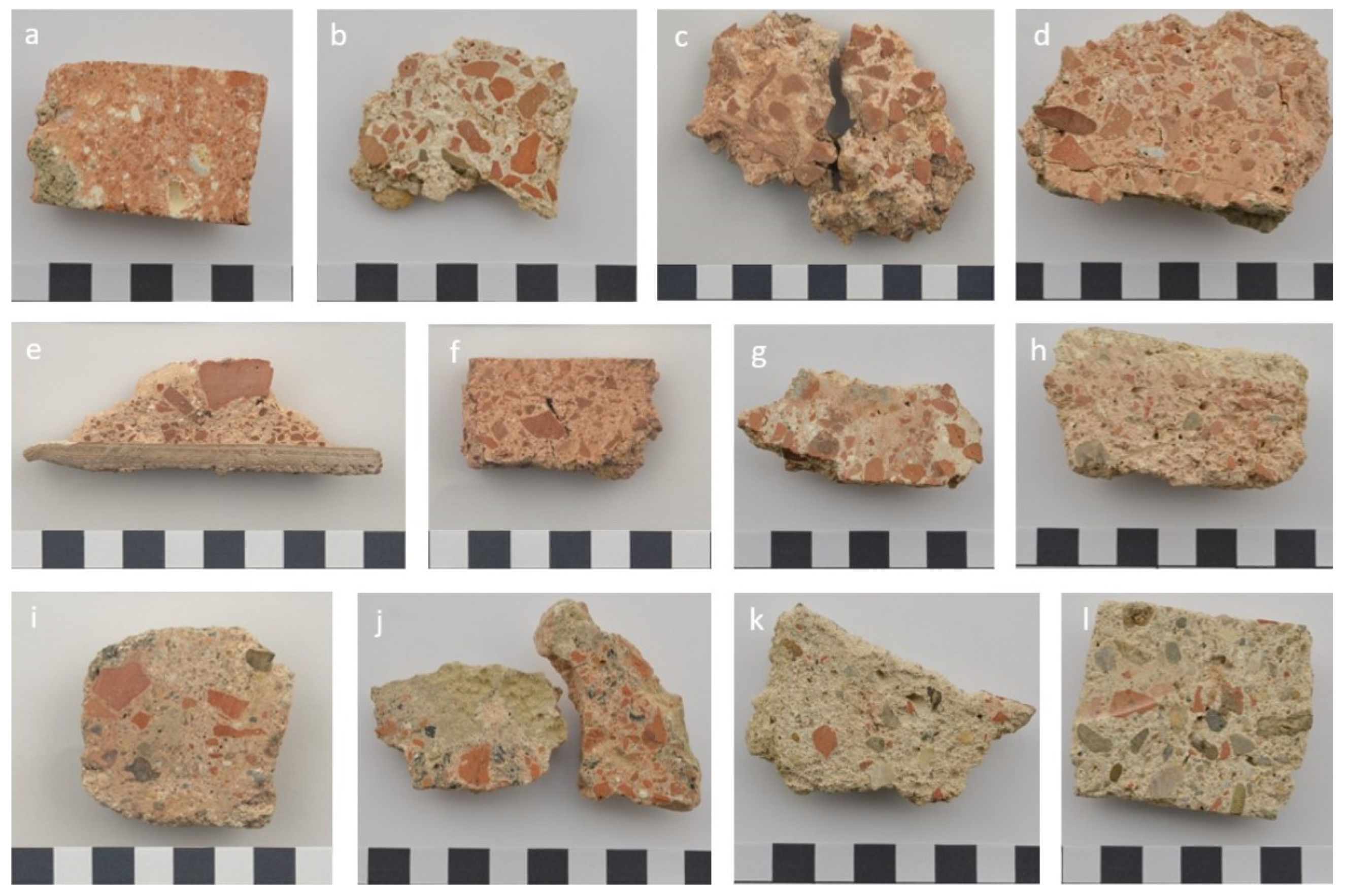
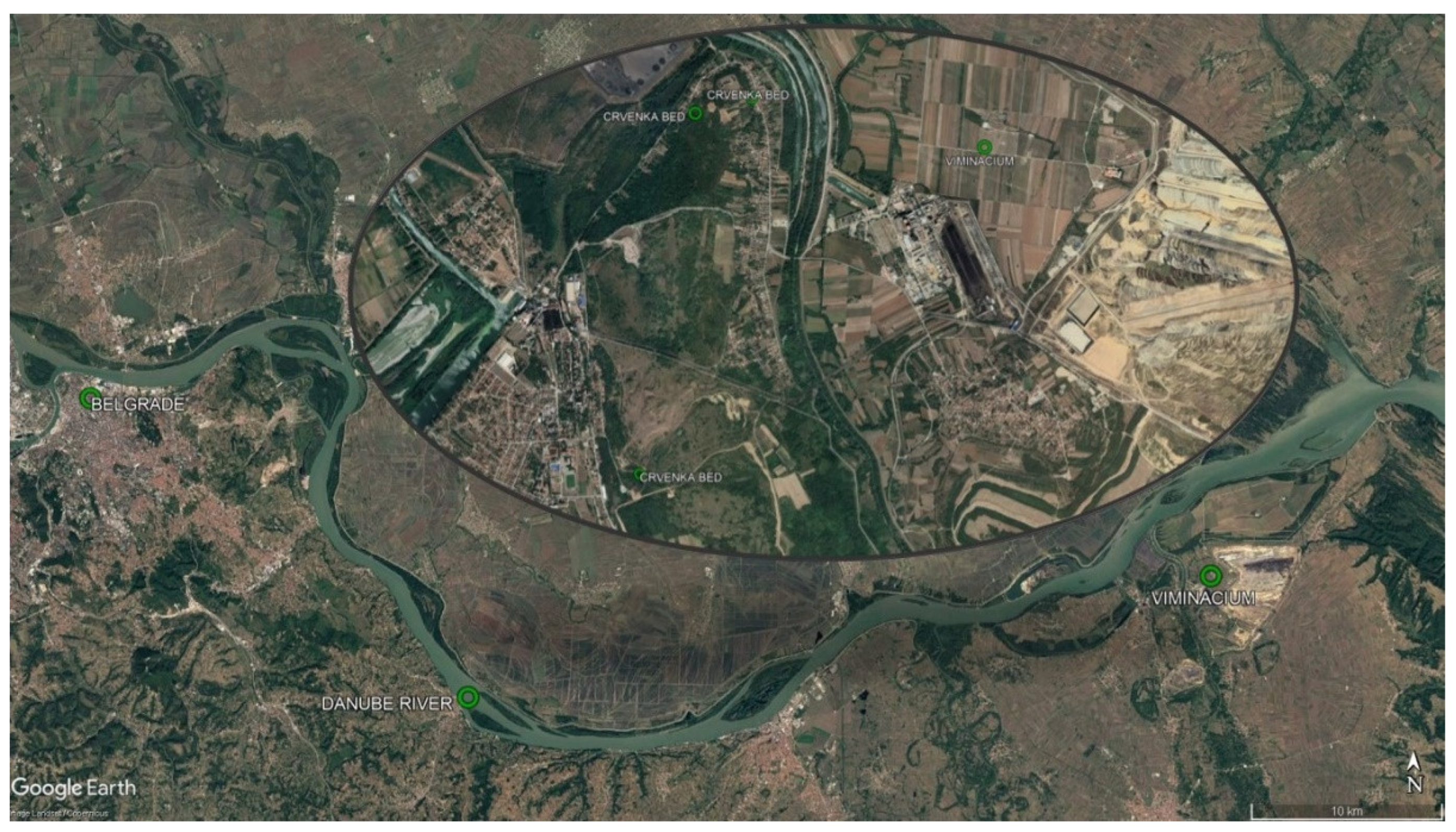
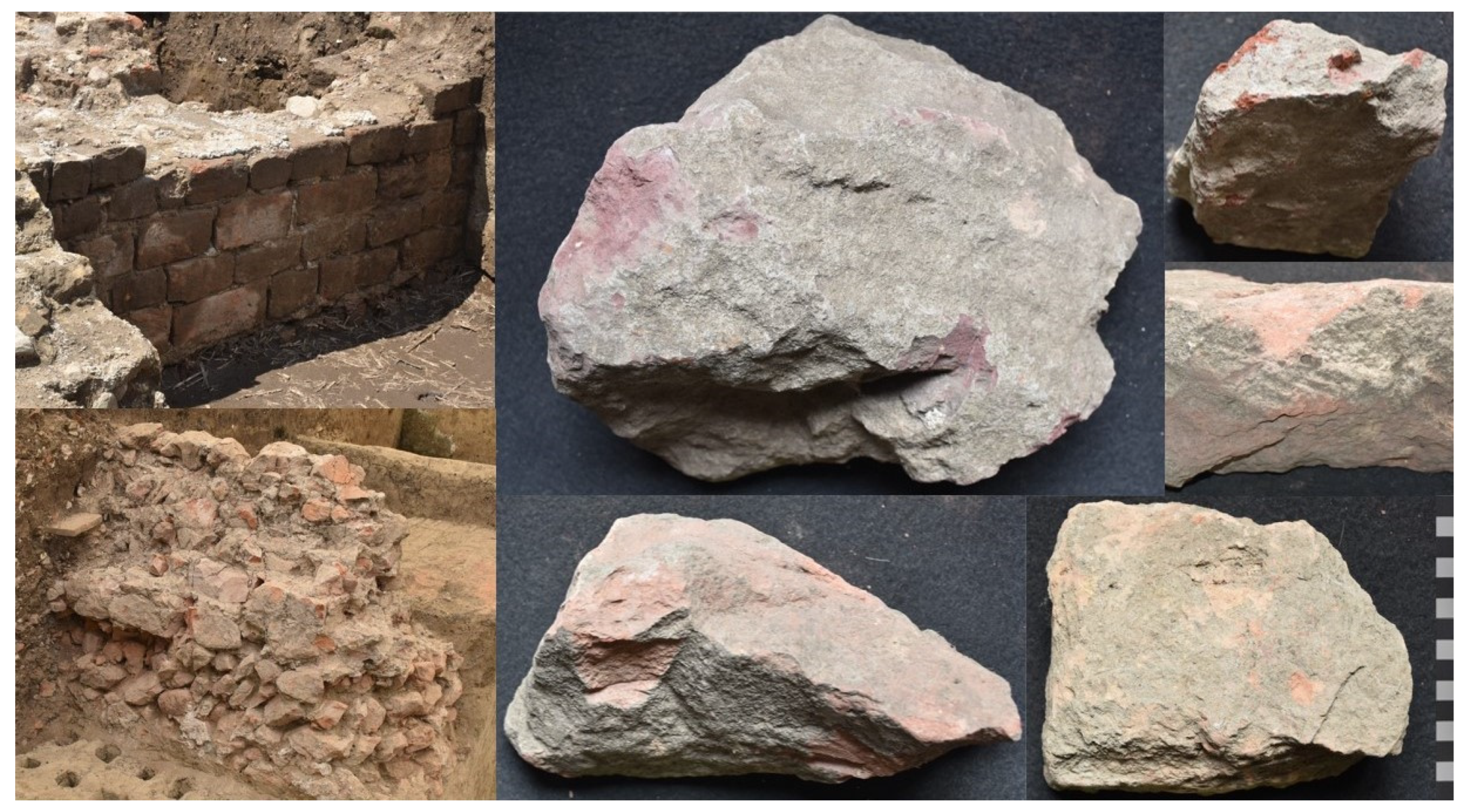
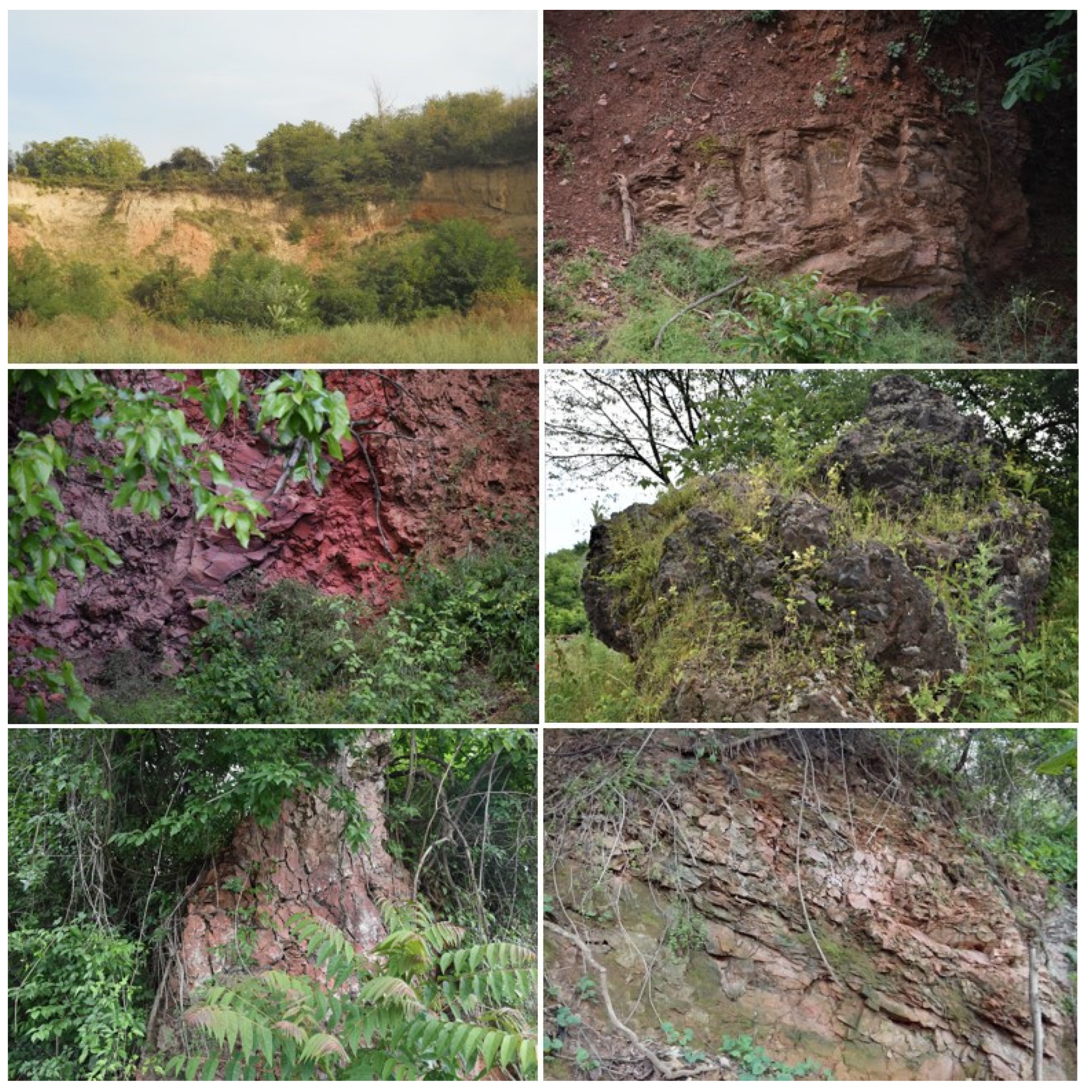
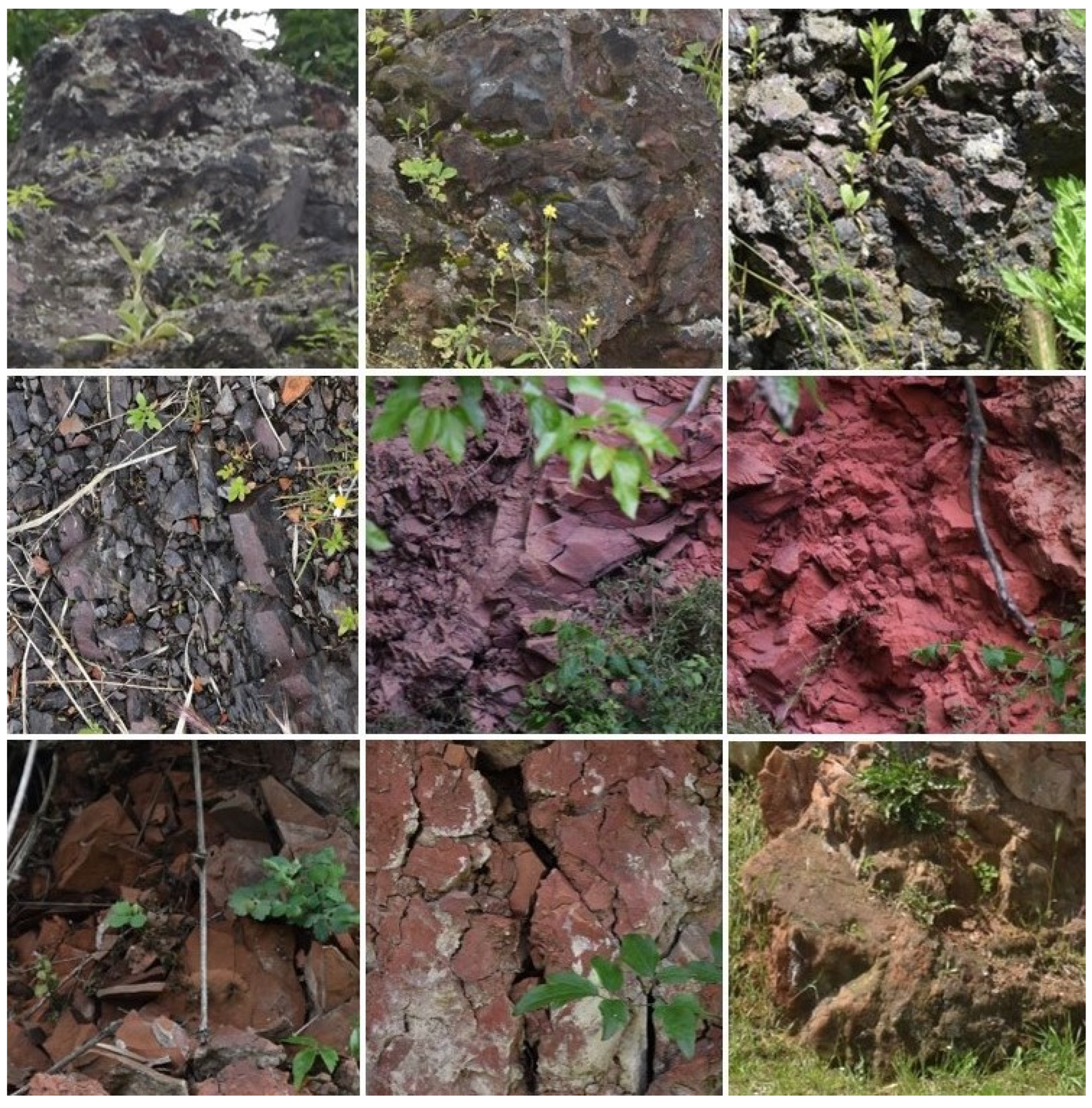
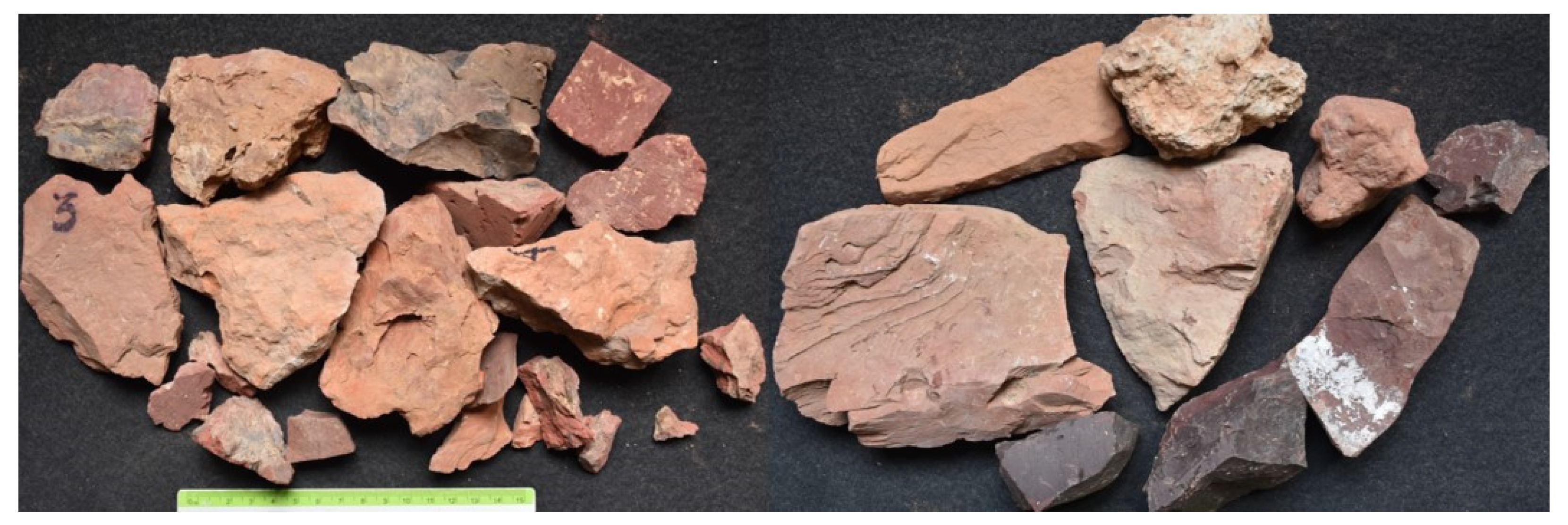
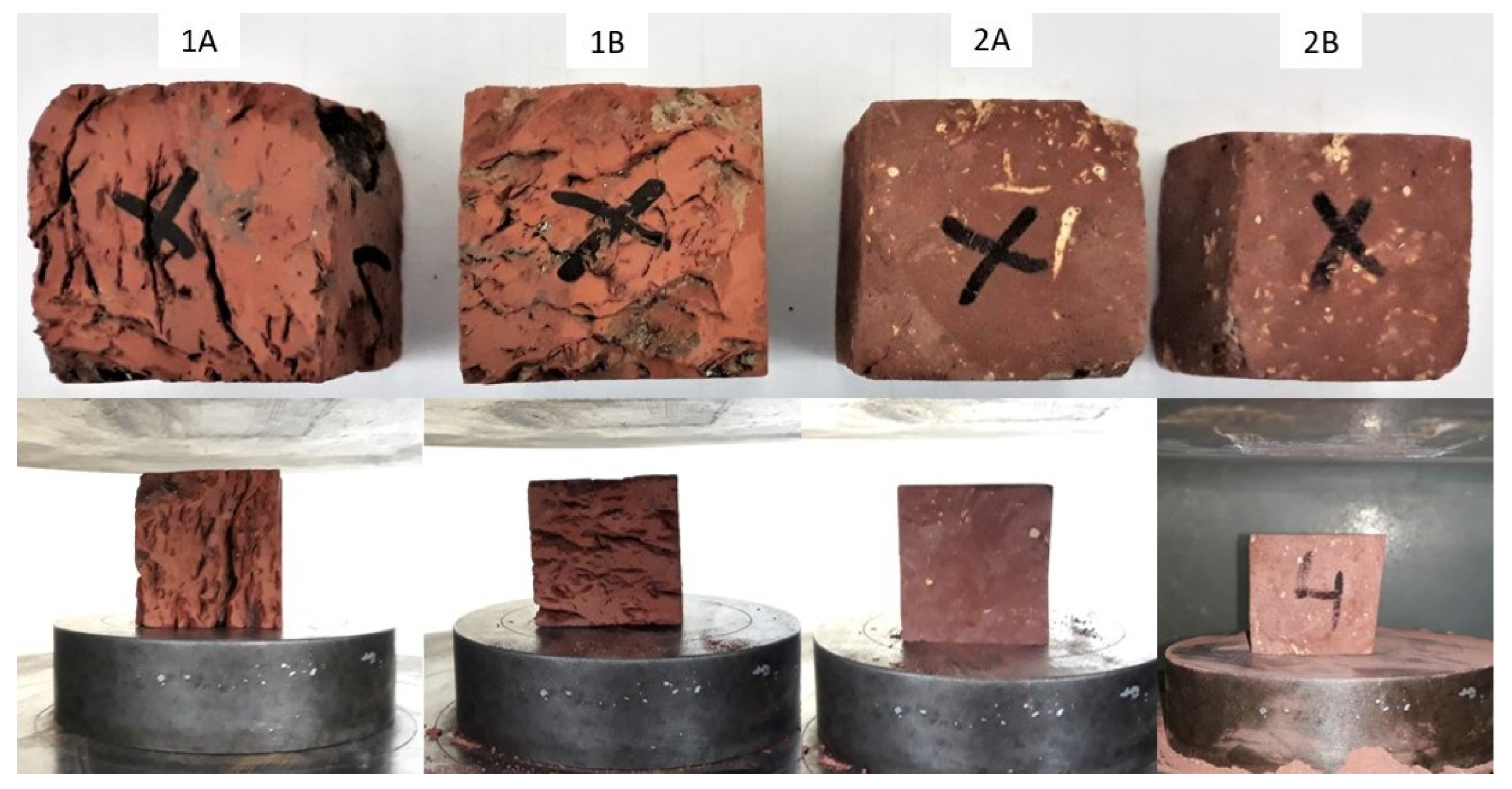
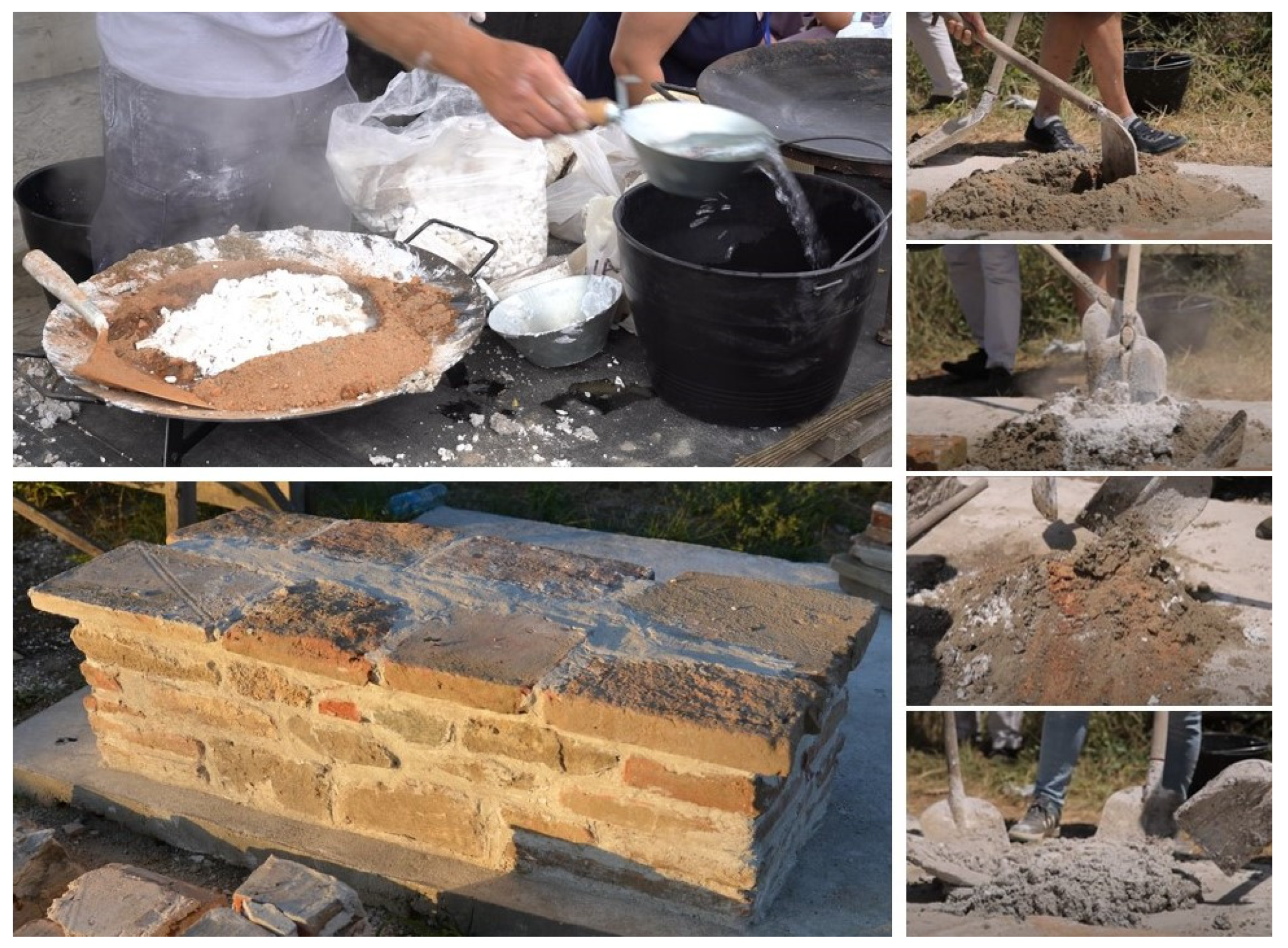
| Sample / cube |
Compression strength (MPa) |
Apparent density (g/cm³) |
Absolute porosity (%) |
Water absorption (%) |
| 1A | 20.67 | 1.547 | 41.73 | 23.67 |
| 1B | 4.33 | 1.485 | 44.07 | 30.05 |
| 2A | 3.36 | 1.682 | 36.65 | 22.06 |
| 2B | 1.42 | 1.966 | 25.95 | 12.76 |
| 3 | 1.98 | 1.827 | 28.07 | 15.48 |
| Sample |
Loss on ignition (1000°C) |
SiO₂ | Al₂O₃ | Fe₂O₃ | CaO | MgO | Na₂O | K₂O | SO₃ | P₂O₅ | MnO | TiO₂ | total |
| Natural brick (1) | 1.23 | 61.97 | 19.36 | 8.19 | 1.70 | 3.01 | 0.46 | 2.18 | 0.06 | 0.17 | 0.28 | 0.97 | 99.57 |
| Natural brick (2) | 2.29 | 61.44 | 17.88 | 7.16 | 3.71 | 3.09 | 0.87 | 2.06 | 0.05 | 0.17 | 0.24 | 0.89 | 99.86 |
| Baked clays from the brick kiln | 1.56- 9.27 |
51.26-68.21 |
15.01-21.88 | 2.66- 8.53 |
1.03- 8.36 |
0.73- 4.70 |
0.71-1.38 | 1.54- 2.94 |
0.05-0.86 | 0.02-0.16 | 99.96-100.34 | ||
| Fired brick | 4.09 | 69.40 | 10.50 | 5.20 | 4.42 | 2.95 | 1.59 | 1.76 | 99.91 |
| Sample |
Compression strength (MPa) |
Flexural strength (MPa) |
| I1 | 3.50 | 1.20 |
| I2 | 3.20 | 1.40 |
| I3 | 3.60 | 1.50 |
| I4 | 3.50 | |
| I5 | 3.40 | |
| I6 | 3.40 | |
| I (avg.) | 3.43 | 1.37 |
| II1 | 5.30 | 1.60 |
| II2 | 5.20 | 2.0 |
| II3 | 5.20 | 1.7 |
| II4 | 5.10 | |
| II5 | 5.00 | |
| II6 | 4.90 | |
| II (avg.) | 5.12 | 1.77 |
Disclaimer/Publisher’s Note: The statements, opinions and data contained in all publications are solely those of the individual author(s) and contributor(s) and not of MDPI and/or the editor(s). MDPI and/or the editor(s) disclaim responsibility for any injury to people or property resulting from any ideas, methods, instructions or products referred to in the content. |
© 2023 by the authors. Licensee MDPI, Basel, Switzerland. This article is an open access article distributed under the terms and conditions of the Creative Commons Attribution (CC BY) license (http://creativecommons.org/licenses/by/4.0/).




